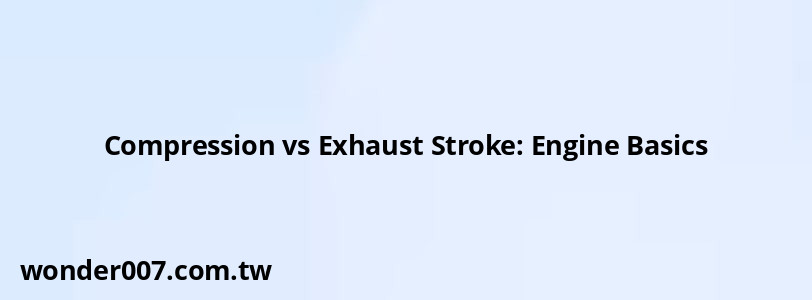Compression vs Exhaust Stroke: Engine Basics

Understanding Engine Strokes
In a four-stroke engine, the compression stroke and exhaust stroke are two crucial phases of the combustion cycle. Distinguishing between these strokes is essential for engine maintenance and troubleshooting.
Compression Stroke
The compression stroke occurs when the piston moves upward, compressing the air-fuel mixture in the cylinder. During this stroke:
- Both intake and exhaust valves are closed
- The piston moves from Bottom Dead Center (BDC) to Top Dead Center (TDC)
- Cylinder pressure increases significantly
- The air-fuel mixture is compressed to a fraction of its original volume
Exhaust Stroke
The exhaust stroke is when the piston pushes out the burnt gases from the cylinder. Key characteristics include:
- The exhaust valve is open
- The piston moves from BDC to TDC
- Cylinder pressure is relatively low
- Burnt gases are expelled from the cylinder
Differentiating Between Strokes
To tell the difference between compression and exhaust strokes:
1. Valve Position: During compression, both valves are closed. In the exhaust stroke, the exhaust valve is open.
2. Cylinder Pressure: Compression stroke has high pressure, while exhaust stroke has low pressure.
3. Piston Movement: Both strokes involve upward piston movement, but for different purposes.
4. Timing: Compression occurs before ignition, exhaust after combustion.
Practical Methods for Identification
1. Spark Plug Hole Test: Remove the spark plug and place your thumb over the hole. During the compression stroke, you'll feel strong pressure pushing against your thumb.
2. Valve Observation: If possible, observe the valves. Closed valves indicate compression, while an open exhaust valve signifies the exhaust stroke.
3. Timing Marks: Use engine timing marks on the flywheel or crankshaft pulley to determine the stroke.
4. Compression Tester: A compression tester can accurately measure cylinder pressure, confirming the compression stroke.
Importance in Engine Maintenance
Understanding these strokes is crucial for:
- Proper Timing: Ensuring correct valve and ignition timing
- Diagnostics: Identifying issues like low compression or valve problems
- Performance Tuning: Optimizing engine performance and efficiency
By recognizing the differences between compression and exhaust strokes, mechanics and enthusiasts can better maintain and troubleshoot engines, ensuring optimal performance and longevity.
FAQs About Compression and Exhaust Strokes
- Can compression occur during the exhaust stroke?
No, compression only occurs during the designated compression stroke when both valves are closed. - How does cylinder pressure differ between these strokes?
Compression stroke has high pressure (up to 200 psi or more), while exhaust stroke has much lower pressure, close to atmospheric. - What happens if you can't distinguish between strokes?
Inability to differentiate can lead to incorrect timing settings, potentially causing engine damage or poor performance.
Related Posts
-
Exhaust System Light on Isuzu NPR: Causes and Fixes
26-01-2025 • 256 views -
2007 Infiniti G35: Troubleshooting Engine Shutdown Issues
29-01-2025 • 126 views -
PCV Valve Diagram for Ford 4.2 Liter V6 Engine
30-01-2025 • 192 views -
V12 Engine Costs: What You Need to Know
26-01-2025 • 679 views -
Mini Cooper Half Engine Light And Loss Of Power
31-01-2025 • 179 views
Latest Posts
-
2015 Chevy Traverse AC Recharge Port Location
01-02-2025 • 409 views -
Power Steering Fluid Leak On Passenger Side
01-02-2025 • 457 views -
Rear Brake Caliper Piston Won't Compress
01-02-2025 • 356 views -
Are O2 Sensors Covered Under Warranty
01-02-2025 • 376 views -
How To Turn Off Paddle Shifters Mercedes
01-02-2025 • 377 views
Popular Posts
-
V12 Engine Costs: What You Need to Know
26-01-2025 • 679 views -
EPC Warning Light: What It Means for Your Vehicle
27-01-2025 • 630 views -
Hino Warning Lights: Understanding Dashboard Alerts
26-01-2025 • 765 views -
EPC Light: Understanding Causes and Solutions
26-01-2025 • 1053 views -
Power Steering and ABS Light On: Causes and Solutions
27-01-2025 • 643 views
